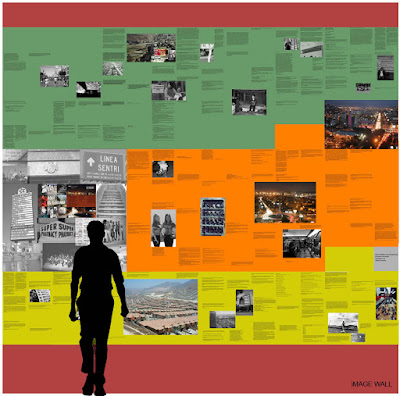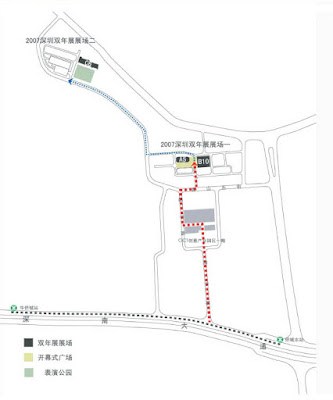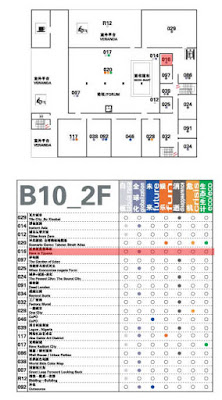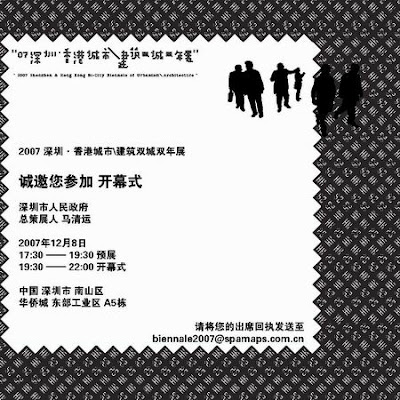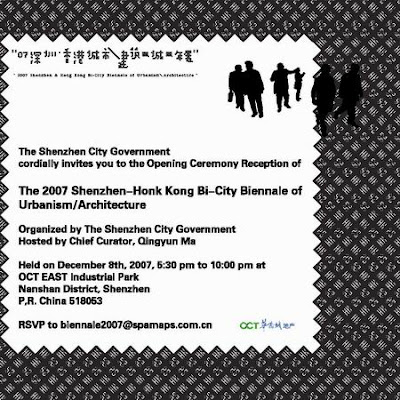Shenzhen & -Hongkong
Bi-City Biennale of Urbanism and Architecture
Generica/Rene Peralta partícipan en la bienal de arquitectura y urbanismo en la ciudad de Shenzhen, China. Evento que se llevara acabo del 08 de Diciembre al 1 de Marzo. la instalación esta compuesta de una exposición gráfica en gran formato del libro Aqui es Tijuana ( de Fiamma Montezemolo, Rene Peralta y Heriberto Yepez) junto con un vídeo de 10 min sobre los tres capítulos del libro (Avatares, Deseos, Permutaciones) producido por Rene Peralta y dirigido por Les Bernstien.
Generica and Rene Peralta are parcipating in Bi-City Biennale of Urbanism and Architecture in the city of Shenzhen, China. The event will take place from December 08 untill March 01. The installation includes large format images of the book Here is Tijuana (by Fiamma Montezemolo, Rene Peralta and Heriberto Yepez) as well as a 10 min. video of the three main chapters of the book (Avatars, Desires, Permutations) produced by Rene Peralta and directed by Les Bernstien.
El video fue producido 90% con fotografia.
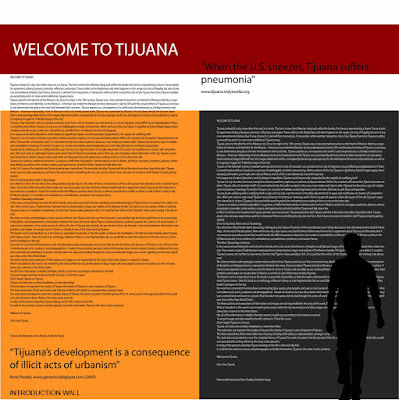 muro de introduccion/ intro wall
muro de introduccion/ intro wall
Qingyun Ma: What do we need and get from the city? Conversely, what do we provide for the city?
Rene Peralta: We need a critical awareness of ourselves from the city.
The city gives us a continuous urban landscape that includes the ugly, the political, catastrophe, memory and in some cases a sense of optimism to evolve as social beings.
Qingyun Ma: Can we trust our judgment of the future?
Rene Peralta: It seems that futures are a thing of the past. In most cases cities are struggling to perceive their own present. A persistent transformation of the city negates a view of a single imaginary future; the city adjusts in space and time. The city de-codifies and re-codifies itself continuously.
Qingyun Ma: Should we invest in intelligence that maximizes a building’s performance in a given time period or in sentiments which demand its perpetuation?
Rene Peralta: In this case if the city is in perpetual state of codification, buildings perform the function of hosting a spatial construct that allow for the creation of a collective memory. In an age of singular buildings, spatial amnesia and urban surveillance, do buildings contribute to reality or to, as Baudrillard mentions, to the fiction of society?
Qingyun Ma: How can we maximize our needs today?
Rene Peralta: By minimizing our consumption, reassigning value and destabilizing power.
Qingyun Ma: Should buildings have expiration dates?
Rene Peralta: If building is a cultural endeavor then the question should also converse if culture also expires? The city is a mental construct and buildings are part of its representational form. But when our perceptions of the city change due to expanding modes of media and communication, the spectacle shapes our perception. Therefore society reduces building to forms of consumption, mere theatrical stages, that do not allow a critical awareness of ourselves.
Qingyun Ma: Should a city stay in its current form forever?
Rene Peralta: Cities are made up processes that involve global and local economies, which reconfigure urban and social networks. Cities can no longer be comprehended as a totality. Therefore by their contemporary nature cities cannot be static entities and their current form is a problem of negotiation rather than ideology.
Qingyun Ma: Can we envision a city composed of temporary buildings, instead of eternal monuments?
Rene Peralta: Cities need singular buildings that produce unique spatial experiences and are part of the collective memory, building which represent grandeur and failure of the society that created them. Urban space can do this as well as Jane Jacobs once mentioned. The demise of our existing structures can only represent our own systems in decadence. Temporality could be a Fad.
Qingyun Ma: What is the polar opposite to the city?
Rene Peralta: Don’t know, there are still so many possible cities. We have not built the last and final one yet.
Qingyun Ma: What is the essence of agriculture?
Rene Peralta: Agriculture is already happening in the southern hemisphere as a method dealing with worst-case scenarios, agriculture is very real and contemporary.
Qingyun Ma: Is agriculture the next form of urbanism?
Rene Peralta: Due to political, economical and environmental instability agriculture can become a self-sustaining project for communities. In the verge of reaching peak oil and other resource depletion, agriculture will be a necessity rather than a trend.
Project collaborators: Salvador Luna, Christine Geronaga , Les Bernstien and made possible by Woodbury University.
Spacial Thanks to architect and good friend Peter Zellner, Co-Curator of the Biennale.


